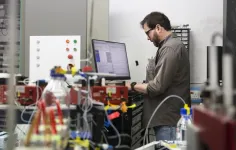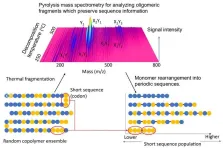(Press-News.org) Predicting a protein’s location within a cell can help researchers unlock a plethora of biological information that’s critical for developing future scientific discoveries related to drug development and treating diseases like epilepsy. That’s because proteins are the body’s “workhorses,” largely responsible for most cellular functions.
Recently, Dong Xu, Curators Distinguished Professor in the Department of Electrical Engineering and Computer Science at the University of Missouri, and colleagues updated their protein localization prediction model, MULocDeep, with the ability to provide more targeted predictions, including specific models for animals, humans and plants. The model was created 10 years ago by Xu and fellow MU researcher Jay Thelen, a professor of biochemistry, to originally study proteins in mitochondria.
“Many biological discoveries need to be validated by experiments, but we don’t want researchers to have to spend time and money conducting thousands of experiments to get there,” Xu said. “A more targeted approach saves time. Our tool provides a useful resource for researchers by helping them get to their discoveries faster because we can help them design more targeted experiments from which to advance their research more effectively.”
By harnessing the power of artificial intelligence through a machine learning technique — training computers to make predictions using existing data — the model can help researchers who are studying the mechanisms associated with irregular locations of proteins, known as “mislocalization,” or where a protein goes to a different place than it’s supposed to. This abnormality is often associated with diseases such as metabolic disorders, cancers and neurological disorders.
“Some diseases are caused by mislocalization, which causes the protein to be unable to perform a function as expected because it either cannot go to a target or goes there inefficiently,” Xu said.
Another application of the team’s predictive model is assisting with drug design by targeting an improperly located protein and moving it to the correct location, Xu said.
This work is currently supported by National Science Foundation. In the future, Xu hopes to receive additional funding to help increase the model’s accuracy and develop more functionalities.
“We want to continue improving the model to determine whether a mutation in a protein could cause mislocalization, whether proteins are distributed in more than one cellular compartment, or how signal peptides can help predict localization more precisely,” Xu said. “While we don’t offer any solutions for drug development or treatments for various diseases per se, our tool may help others for their development of medical solutions. Today’s science is like a big enterprise. Different people play different roles, and by working together we can achieve a lot of good for all.”
Xu is currently working with colleagues to develop a free, online course for high school and college students based on the biological and bioinformatics concepts used in the model and expects the course will be available later this year.
A conflict of interest is also noted by Xu and colleagues: While the online version of MULocDeep is available for use by academic users, a standalone version is also available commercially through a licensing fee.
“MULocDeep web service for protein localization prediction and visualization at subcellular and suborganellar levels,” was published in the journal Nucleic Acids Research. Co-authors are Yuexu Jiang, Lei Jiang, Chopparapu Sai Akhil, Duolin Wang, Ziyang Zhang and Weinan Zhang at MU.
END
AI software can provide ‘roadmap’ for biological discoveries
University of Missouri researchers update an online prediction modeling tool to help advance other researchers’ scientific discoveries involving proteins.
2023-06-02
ELSE PRESS RELEASES FROM THIS DATE:
Study helps explain what drives psoriasis severity and offers clues as to how disease may spread to other body parts
2023-06-02
Beneath and beyond the reddish, flaky lesions that form in the skin of those with psoriasis, mild and severe forms of the disease can be told apart by the activity of key cells and signaling pathways, a new study shows.
Led by researchers at NYU Grossman School of Medicine, the study mapped hidden features of inflammation and how they compared in cases of increasing severity of psoriatic disease. The team’s findings may help explain how small areas of skin inflammation can have wide-ranging effects in other parts of the body. Up to one-fifth of those with the skin disease, the researchers note, ...
New study finds strengthening protection of existing parks is crucial for biodiversity conservation
2023-06-02
-With pictures-
In a new study, bioscientists argue that strengthening the protection given to areas already protected under law or by local communities is as critical for safeguarding biodiversity as creating new protected areas.
The research team, which included scientists from Durham University, National University of Singapore (NUS) and Princeton University, found that about 70 per cent of the roughly 5000 species analysed either have no apparent representation in protected areas, occur in protected areas that have been downgraded, downsized or degazetted, ...
Scientists reveal new details of cellular process which prevents spread of cancer
2023-06-02
Researchers have for the first time characterised a unique molecular mechanism of the early stages of programmed cell death or apoptosis, a process which plays a crucial role in prevention of cancer.
The study, which is published today (Friday 2nd June 2023) in Science Advances, was led by Dr Luke Clifton at the STFC ISIS Neutron and Muon Source (ISIS) in Oxfordshire, alongside co-lead Professor Gerhard Gröbner at the University of Umeå and partners at the European Spallation Source in Sweden. It is ...
Development of an AI-based mass spectrometric technique capable of determining the monomeric sequence of a polymer
2023-06-02
1. The National Institute for Materials Science (NIMS) has developed an AI-based mass spectrometric technique capable of determining the monomeric sequence of a polymer. This technique may be useful in gaining a deeper understanding of basic polymeric structures, facilitating the development of new materials and helping solve plastic recycling problems.
2. A polymer is a very large molecule composed of a chain of many (ranging from hundreds to hundreds of thousands) small molecules called monomers that are bonded together. Many common polymers (e.g., plastics and resins) are copolymers, consisting of several different types of monomers. During the copolymerization process, the monomers ...
Non-invasive treatment of uterine fibroids research project secures grant at Baton Rouge Health-Tech Catalyst Pitch Night
2023-06-02
BATON ROUGE – A collaboration among Dr. Frank Greenway of Pennington Biomedical Research Center, Dr. Beverly Ogden of Woman’s Hospital in partnership with LSU, and the University of Louisiana at Lafayette, was named as one of three award recipients at the Baton Rouge Health-Tech Catalyst Pitch Night. The team will investigate non-invasive treatment of uterine fibroids, or benign growths, such as leiomyomas or myomas, that development from the muscle tissue of the uterus.
“Fibroids are non-cancerous tumors in the wall of the uterus that are common, and can cause bleeding, pain, and infertility,” ...
nTIDE May 2023 Jobs Report: Job numbers rebound bringing people with disabilities close to previous high in employment
2023-06-02
East Hanover, NJ – June 2, 2023 – In a sharp reversal, employment indicators rebounded for people with disabilities in May, according to today’s National Trends in Disability Employment – semi-monthly update (nTIDE), issued by Kessler Foundation and the University of New Hampshire’s Institute on Disability (UNH-IOD). Employment appears to be remaining strong despite the threats to the labor market posed by the debt ceiling crisis and ongoing efforts to control inflation.
Month-to-Month nTIDE Numbers (comparing April 2023 to May 2023)
Based ...
American Tinnitus Association elects Wayne State researcher as new chair
2023-06-02
DETROIT – The American Tinnitus Association (ATA) has elected Jinsheng Zhang, Ph.D., professor and chair of the Department of Communication Sciences and Disorders in Wayne State University’s College of Liberal Arts and Sciences, as the new chair of its board of directors. With decades of experience in tinnitus research and work with the ATA, Zhang aims to assist with proactive recruitment of scientists to the field of tinnitus and engage more researchers in ATA grant opportunities that will spur progress toward more effective treatments and cures.
Tinnitus ...
Media Alert: American College of Cardiology to host Sports Cardiology Conference
2023-06-02
The American College of Cardiology will host the annual Care of the Athletic Heart course on June 8-10, 2023, in Washington, including poster abstracts and educational sessions. The course is designed for all clinicians who provide cardiovascular care for the professional, occupational, tactical or recreational athlete. As the athletic population expands to all demographic groups, it is critical that there is a larger contingent of clinicians who understand the latest care and practice management for athletes at every level.
Dermot Phelan, BAO, MBBCh, PhD, FACC, and Megan Wasfy, ...
Immunotherapy for brain cancer metastases shows clinical benefit
2023-06-02
In a phase 2 clinical trial of the immune checkpoint inhibitor pembrolizumab, investigators found that 42 percent of patients with metastatic brain cancer benefited from the therapy, with seven patients in the trial surviving longer than two years. The authors caution that these benefits must be weighed against risk of toxicity, but, overall, the study shows promising results that warrant larger studies and efforts to identify patients most likely to benefit from this treatment. Their findings are published in Nature Medicine and presented simultaneously at the 2023 ASCO Annual Meeting on June 2.
“There ...
Commentary calls for equal access to healthcare for DACA recipients and all immigrants
2023-06-02
The paper, published April 17 in The Lancet Regional Health – Americas, was co-authored by Dr. Gunisha Kaur, an associate professor of anesthesiology at Weill Cornell Medicine and medical director of the Weill Cornell Center for Human Rights; Stephen Yale-Loehr, a professor of immigration law practice at Cornell Law School; and Jin K. Park, a medical student at the Harvard School of Medicine and the first DACA recipient awarded a Rhodes Scholarship.
“The erratic enforcement of the DACA program since its inception has led many immigrants and their families to disengage completely from the healthcare system to avoid risking deportation,” said ...
LAST 30 PRESS RELEASES:
Science briefing: An update on GLP-1 drugs for obesity
Lower doses of immunotherapy for skin cancer give better results
Why didn’t the senior citizen cross the road? Slower crossings may help people with reduced mobility
ASH 2025: Study suggests that a virtual program focusing on diet and exercise can help reduce side effects of lymphoma treatment
A sound defense: Noisy pupae puff away potential predators
Azacitidine–venetoclax combination outperforms standard care in acute myeloid leukemia patients eligible for intensive chemotherapy
Adding epcoritamab to standard second-line therapy improves follicular lymphoma outcomes
New findings support a chemo-free approach for treating Ph+ ALL
Non-covalent btki pirtobrutinib shows promise as frontline therapy for CLL/SLL
University of Cincinnati experts present research at annual hematology event
ASH 2025: Antibody therapy eradicates traces of multiple myeloma in preliminary trial
ASH 2025: AI uncovers how DNA architecture failures trigger blood cancer
ASH 2025: New study shows that patients can safely receive stem cell transplants from mismatched, unrelated donors
Protective regimen allows successful stem cell transplant even without close genetic match between donor and recipient
Continuous and fixed-duration treatments result in similar outcomes for CLL
Measurable residual disease shows strong potential as an early indicator of survival in patients with acute myeloid leukemia
Chemotherapy and radiation are comparable as pre-transplant conditioning for patients with b-acute lymphoblastic leukemia who have no measurable residual disease
Roughly one-third of families with children being treated for leukemia struggle to pay living expenses
Quality improvement project results in increased screening and treatment for iron deficiency in pregnancy
IV iron improves survival, increases hemoglobin in hospitalized patients with iron-deficiency anemia and an acute infection
Black patients with acute myeloid leukemia are younger at diagnosis and experience poorer survival outcomes than White patients
Emergency departments fall short on delivering timely treatment for sickle cell pain
Study shows no clear evidence of harm from hydroxyurea use during pregnancy
Long-term outlook is positive for most after hematopoietic cell transplant for sickle cell disease
Study offers real-world data on commercial implementation of gene therapies for sickle cell disease and beta thalassemia
Early results suggest exa-cel gene therapy works well in children
NTIDE: Disability employment holds steady after data hiatus
Social lives of viruses affect antiviral resistance
Dose of psilocybin, dash of rabies point to treatment for depression
Helping health care providers navigate social, political, and legal barriers to patient care
[Press-News.org] AI software can provide ‘roadmap’ for biological discoveriesUniversity of Missouri researchers update an online prediction modeling tool to help advance other researchers’ scientific discoveries involving proteins.



